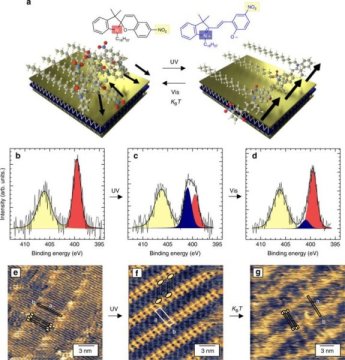[ad_1]
Graphene and related materials hold great potential for technological applications such as electronics, sensors, and energy storage devices, among others. Thanks to their high surface sensitivity, these materials are an ideal platform to study the interplay between molecular assemblies at the nanoscale and macroscopic electrical phenomena.
Researchers within the Graphene Flagship designed a molecule that can reversibly undergo chemical transformations when illuminated with ultraviolet and visible light. This molecule -a photoswitchable spiropyran- can be then anchored to the surface of materials such as graphene or molybdenum disulfide, thus generating an atomically precise hybrid macroscopic superlattice. When illuminated, the whole supramolecular structure experiences a collective structural rearrangement, which could be directly visualized with a sub-nanometer resolution by scanning tunneling microscopy.
More importantly, this light-induced reorganization at the molecular level induces large changes in the macroscopic electrical properties of the hybrid devices. The molecules, together with the layers of graphene and related materials, can convert single-molecule events into a spatially homogeneous switching action that generates a macroscopic electrical response. This novel and versatile approach takes supramolecular electronics to the next level.
‘Thanks to this new approach, we can exploit the capacity of collective switching events occurring in superlattices of photochromic molecules assembled onto graphene and related materials to induce large scale and reversible modulation in the electrical properties of high-performance opto-electronic devices,’ explains Paolo Samorì, lead author of the paper. ‘This technology could find applications in the next generation of smart and portable electronics, with programmable properties,’ he adds.
Samorì also explains how this idea of tailoring molecular superlattices could generate a wide variety of new materials with tunable and responsive properties. ‘To dial your functions! You only need to carefully choose the right molecules, the thus-formed superlattice will allow to maximize the change in properties as a response to external inputs,’ he says.
Vittorio Pellegrini, researcher at IIT and Division Leader for Energy, Composites, and Production at the Graphene Flagship, highlights how the research is ‘unique in the way it combines graphene and other related materials with light-responsive chemical molecules. These macroscopic arrangements are promising platforms for optoelectronics.’ Pellegrini points out the outstanding potential of these new findings: ‘the molecular ultra-thin coating can be tailored just by synthesizing different molecules.’ Moreover, ‘this discovery will lead us to the development of devices, as the technique developed by Samorì and his team can be scaled up in reproducible manner,’ he added. Samorì agrees: ‘The limit in the scalability is the accessibility to ultra-flat and atomically precise graphene and related materials.’
These advances, made possible by the collaborative environment of the Graphene Flagship, could lead to promising applications in sensors, optoelectronics, and flexible devices. Researchers now dream of high-performance multifunctional hybrid devices under control of nature’s most abundant and powerful source of energy — light.
Story Source:
Materials provided by Graphene Flagship. Note: Content may be edited for style and length.
[ad_2]















